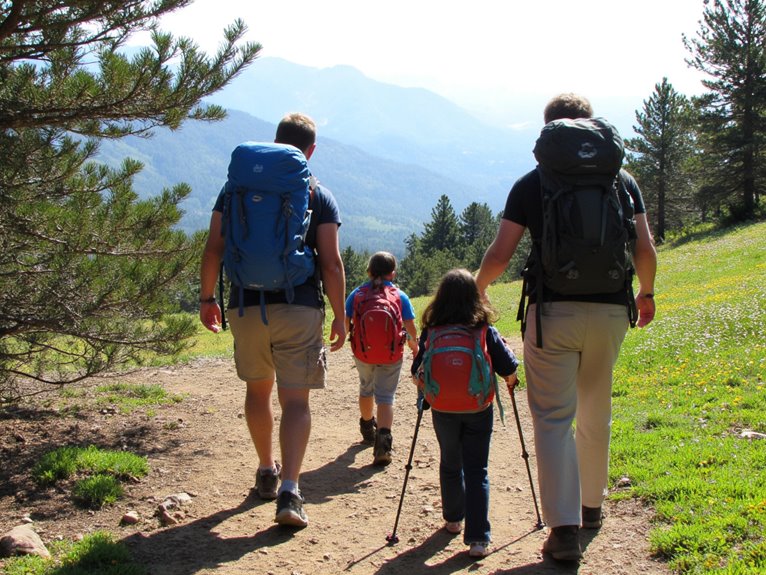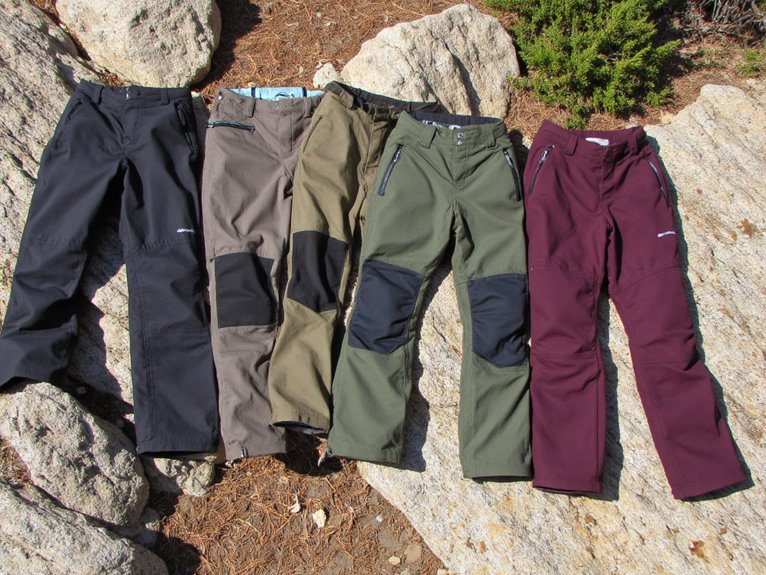How Do I Pack for a 7 Day Hike?
When planning a 7-day hike, prioritize packing essential items that guarantee your safety, comfort, and overall well-being. Begin by selecting clothing and footwear suitable for various conditions, including moisture-wicking base layers, insulating layers, and waterproof jackets. Shelter and sleeping gear, such as a sturdy tent and sleeping bag, are also indispensable. Navigation and safety tools, like a topographic map, compass, and first aid kit, are essential for staying on track and responding to emergencies. Don't forget personal hygiene items, a well-stocked first aid kit, and a thoughtful meal plan. As you prepare, bear in mind that every item counts, and the right gear can make all the difference – discover the specifics that will make your journey a success.
We are supported by our audience. When you purchase through links on our site, we may earn an affiliate commission, at no extra cost for you. Learn more. Last update on 7th January 2026 / Images from Amazon Product Advertising API.
Essential Items to Pack First
At a minimum, a hiker should pack seven days' worth of clothing, including a base layer, insulating layer, and waterproof jacket to provide adequate protection from the elements and guarantee a safe journey.
These essential items should be packed first to avoid their omission. The base layer should be moisture-wicking, the insulating layer should provide warmth, and the waterproof jacket should be both breathable and durable.
Additionally, a hat, gloves, and extra socks should be packed to maintain body heat and prevent blisters.
These items are vital for a safe and comfortable hike, and should be packed before any other items. By prioritizing these essentials, hikers can guarantee a successful and enjoyable journey.
Clothing for Various Conditions
A hiker's clothing selection should be tailored to the specific conditions they are likely to encounter on their 7-day hike, including varying temperatures, precipitation, and sunshine.
Pack layers of breathable, moisture-wicking clothing to adapt to changing conditions. Include a base layer of thermal tops and leggings, insulating mid-layers like fleece jackets and pants, and a waterproof and windproof outer layer.
Consider the activity level and terrain when selecting clothing, opting for quick-drying fabrics and articulated designs for ease of movement.
Don't forget a warm hat and gloves for colder climates, as well as a lightweight rain jacket for unexpected showers.
Footwear and Sock Selection
When it comes to Footwear and Sock Selection for a 7-day hike, making the right choices is crucial for comfort, performance, and overall success.
Hikers have several options to consider, including hiking boots, trail running shoes, and socks made from various materials, each with their unique benefits and drawbacks.
Hiking Boot Options
Hikers have two primary options for footwear on a 7-day hike: lightweight hiking shoes and sturdy hiking boots, each with its own set of advantages and disadvantages.
Lightweight shoes are ideal for well-maintained trails with minimal obstacles, offering better breathability and flexibility. They are also generally lighter and more comfortable, making them suitable for faster-paced hikes.
On the other hand, sturdy hiking boots provide superior ankle support and protection from rough terrain, making them a better choice for rugged trails with steep inclines, rocky terrain, or inclement weather.
When choosing between the two, consider the terrain, weather, and your personal hiking style to guarantee you select the most suitable footwear for your 7-day hike.
Trail Running Shoes
In situations where a lightweight and agile approach is desired, trail running shoes emerge as a viable option for 7-day hikes, offering a unique blend of comfort, flexibility, and responsiveness.
These shoes are designed for speed and agility, making them ideal for hikers who prioritize efficiency and want to cover long distances quickly.
Trail running shoes typically feature a more minimalist design, which reduces weight and increases flexibility. This results in a more natural stride and improved proprioception.
Additionally, they often have aggressive tread patterns, providing reliable traction on varied terrain.
When choosing trail running shoes, consider the terrain, weather, and your personal hiking style to guarantee the best fit for your 7-day adventure.
Sock Material Selection
Selecting the right sock material is essential for a comfortable and blister-free hiking experience, as it directly impacts moisture management, breathability, and thermal regulation.
Merino wool socks are an excellent choice, as they provide superb moisture-wicking properties, breathability, and thermal regulation. They also naturally resist odor-causing bacteria, reducing the risk of blisters and discomfort.
Synthetic socks, such as those made from nylon or polyester, are also a good option, offering quick drying and moisture-wicking properties.
Avoid cotton socks, as they retain moisture and can lead to blisters.
Look for socks with a seamless construction and a snug fit to reduce blisters and hotspots.
Consider packing multiple pairs to change into during your hike, ensuring your feet stay dry and comfortable.
Shelter and Sleeping Gear
A sturdy and reliable shelter system is essential for a safe and comfortable 7-day hike, as it provides protection from the elements and a good night's sleep.
When selecting a tent, consider factors such as weight, waterproofing, and ease of setup. A freestanding tent with a rain fly and vestibule provides ample space and protection.
Sleeping gear is equally essential, and a sleeping bag with a comfort rating suitable for the expected low temperature is imperative. A sleeping pad, either inflatable or foam, provides insulation and comfort.
Don't forget a ground cloth or tarp to protect the tent from moisture and abrasion. By prioritizing shelter and sleeping gear, you'll be well-rested and prepared for the challenges of the trail.
When venturing into the backcountry for seven days, navigating the wilderness and responding to emergencies is crucial.
A reliable navigation system is vital to staying on track and finding your way back in case of an emergency.
Pack a topographic map, compass, and GPS device or satellite messenger. Bring extra batteries and a repair kit for your GPS device.
A first aid kit is also essential, including supplies for wound cleaning, pain relief, and blister care.
A whistle, fire starter, and emergency shelter can help you signal for help and stay safe in extreme weather conditions.
Don't forget a headlamp or flashlight, extra batteries, and a backup power source.
Personal Hygiene and Sanitation
While venturing into the wilderness for an extended period, maintaining personal hygiene and sanitation is crucial to prevent the spread of illnesses and maintain a healthy environment.
Pack biodegradable soap, toilet paper, and hand sanitizer to maintain cleanliness. Bring a small supply of baby wipes for quick cleanups.
For feminine hygiene, consider packing sanitary products and a small container for disposal.
Don't forget a small trowel for digging catholes and a small container for storing toilet paper and hand sanitizer.
Remember to bury human waste at least 200 feet away from water sources and cover with soil.
First Aid Kit Essentials
Regularly, accidents can happen on the trail, making it essential to carry a well-stocked first aid kit that contains items to treat minor injuries and stabilize more severe ones until medical help arrives.
A basic first aid kit should include bandages, antiseptic wipes, pain relievers, and antibiotic ointments to treat cuts and scrapes.
Additionally, include items such as tweezers, scissors, and thermometers to help with wound cleaning and diagnosis.
Don't forget to pack any personal medications, such as epinephrine auto-injectors or inhalers, and be sure to check their expiration dates.
It's also a good idea to bring a guidebook on wilderness first aid to help you respond to emergencies.
Always check the expiration dates of your supplies and restock as needed.
Food and Water Planning
When venturing into the wilderness for an extended period, proper food and water planning is crucial to maintain energy levels and overall health.
A well-thought-out meal plan and adequate hydration strategy can make all the difference in a successful and enjoyable hike.
In the following sections, we will outline essential meal planning strategies and hydration essentials to ensure a safe and satisfying 7-day hiking experience.
Meal Planning Strategies
A well-planned meal strategy is essential for maintaining energy levels and overall health during a 7-day hike, as a single day's calories can be equivalent to burning 4,000 to 6,000 calories.
To guarantee you're fueling your body adequately, consider the following meal planning strategies:
Pack high-calorie, nutrient-dense foods: Focus on lightweight, high-calorie foods such as nuts, dried fruits, and jerky to provide sustained energy.
Plan meals around your hiking schedule: Divide your day into segments, allocating meals and snacks accordingly to maintain energy levels.
Consider dehydrated meals and instant soups: These options are lightweight, easy to prepare, and provide essential nutrients.
Hydration Essentials Checklist
Proper hydration is critical on a 7-day hike, as inadequate fluid intake can lead to fatigue, decreased cognitive function, and even serious health complications.
To guarantee adequate hydration, pack a hydration system that includes a water filter or purification tablets, a water bladder or hydration pack, and a refillable water bottle.
Bring a water treatment method, such as a portable stove or water purification tablets, to safely treat water from natural sources.
Additionally, pack electrolyte-rich drinks or tablets to replenish lost salts and minerals.
Aim to drink at least 2-3 liters of water per day, and more in hot or high-altitude conditions.
Monitor your urine output and color to confirm proper hydration.
Cooking and Stove Options
Selecting the right cooking and stove options is vital for a successful 7-day hike, as it can make a significant difference in your overall comfort and energy levels.
When choosing a stove, consider the weight, fuel efficiency, and reliability of the device.
Stove Type: Decide between a canister stove, liquid fuel stove, or alternative options like a camping grill or solar oven.
Cookware: Pack lightweight, durable, and non-stick cookware that can withstand high temperatures and is easy to clean.
Fuel and Accessories: Don't forget to pack fuel, a lighter or matches, and a repair kit to ensure your stove remains functional throughout the hike.
Miscellaneous but Crucial Items
Seven often-overlooked yet crucial items can make a significant difference in the success and comfort of your 7-day hike.
First, a small repair kit with safety pins, duct tape, and a multi-tool can help fix broken gear.
A small supply of baby wipes and hand sanitizer will help maintain personal hygiene.
Additionally, a portable charger for your phone or GPS device can be a lifesaver.
Don't forget a small notebook and pen for recording important notes or leaving messages.
Furthermore, a small amount of toilet paper and a hand trowel for digging catholes will promote a sanitary and environmentally-friendly experience.
These miscellaneous items may seem trivial, but they can greatly impact the overall quality of your hiking experience.



